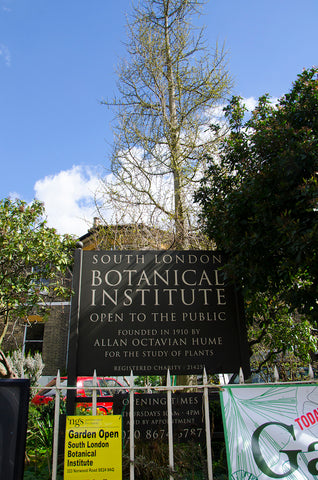South London Botanical Institute


The SLBI is an organization in the best British tradition: altruistic, egalitarian and just a little eccentric. Founded over 100 years ago by A O Hume, a retired Indian Civil Servant, the SLBI is dedicated to encouraging and enabling local people to study botany.


The Institute’s rather formal nomenclature, with its whiff of worthy Edwardian self-improvement, is misleading. The organisation is in fact notably inclusive and friendly, and is open to professional and amateur botanists or indeed anyone with an interest in learning about plants. The well-used education room brims with specimens being scrutinised by after schools science clubs. Annual membership currently stands at £18, for which members get the run of the institute’s facilities, including its well-stocked library and microscope room, a varied programme of lectures by distinguished botanists, social events and field trips (excluding travel costs and entrance fees). Members can also get involved with research projects such as the long-running survey of St Leonard’s churchyard in Streatham – the findings of which will feed into the London Flora currently being prepared. Courses in botanical illustration are run twice yearly and there is often a plant themed art exhibition to admire in the upstairs meeting room. At the heart of the Institute’s resources is the Herbarium, a historic collection of over 100,000 dried plant, lichen, algae and fungi specimens, diligently mounted on card, annotated, and stored in the original black iron cabinets designed by AO Hume. Many specimens are over 100 years old and are an invaluable resource for botanists today. Consisting of several herbaria, the collection, with typical SLBI idiosyncrasy, contains a particularly strong record of Shetland Isles flora. A HLF funded project has recently got underway to conserve the herbarium and bring it into the digital age, making it accessible to all; the project should complete in 2018.


The SLBI is still based in its original home in Tulse Hill, the magnificent mature Ginkgo biloba in the front drive perhaps the first hint to the unsuspecting passerby that this is no ordinary Victorian house on Norwood Road. For, in addition to its other resources, the SLBI has the perfect aid to plant study in the shape of its own botanic back garden. Measuring just 24 x 16 metres, it is billed as ‘London’s smallest botanic garden’ but size appears to be no object to its ambition and its neatly labelled beds contain over 500 species. The garden was a feature of the SLBI from its inception, when it was described at a ‘living museum of strange visitors’. Today, although none of the original ‘strangers’ have survived, the garden is packed with interesting specimens from home and abroad, exploring a lively selection of botanic themes.

Visits to the garden get off to a bloodthirsty start in the greenhouse, whose collection of carnivorous plants provides a grisly source of fascination particularly for younger visitors. The Australasian bed showcases the extraordinary range of plant life from down under, including 18th-century introductions by the plant hunter Joseph Banks such as Sophora tetraptera (New Zealand Kowhai), and Callistemon citrinus (bottlebrush). Closer to home the ‘weed garden’ flies the flag for British native plants – its label is ironic since these plants used to be regarded as weeds. Over in the Dry Border, Mediterranean plants take centre stage with grey leaved toughies like Stachys byzantina (lamb’s ears) and Phlomis italica specially adapted to reduce evaporation, and succulents such as Sedum populifolium which have their own in-house water supply in their fleshy stems. Fragrant plants like rosemary, lavender and sage are also drought resistant but other scented plants are given their own border. This includes Iris ‘Florentina’ – whose violet scented roots are used in the perfume trade – and its foul smelling relative, Iris foetidissima. Medicinal plants strut their stuff in two borders, one of which is themed around Gerard’s Herball of 1596, the other exploring pharmaceutical and medicinal plant remedies. By way of counterpoint, poisonous plants in the garden include deadly nightshade, aconite and poison ivy. Over by the pond there’s a bed dedicated to monocots, an important division of the plant kingdom whose subjects are defined as having only one seed leaf (cotyledon). Monocots include grasses, bamboos and palms, sedges and architectural plants such as Cordyline australis, as well as native flowers like Iris pseudacorus (yellow flag iris) and later summer flowering South African plants like Eucomis bicolor. The garden is also home to London’s first moss trail, a collection of twelve different mosses and liverworts whose common names alone make you want to track them down: Bird’s-claw beard moss (Barbula unguiculata) and Swan’s neck thyme moss (Mnium hornum).

Formally laid out and packing a lot of plants into its modest urban footprint, the garden is tended by part-time gardener Sarah Davey, and an assistant, together with volunteer help from members. This verdant plot is a popular venue for plant sales and events such as the Open Garden Squares Weekend and the Chelsea Fringe. SLBI events are famous for the excellence of their cakes; members can also enjoy the garden with a glass of wine on summer ‘twilight’ openings.


Having celebrated its centenary in 2010, the SLBI has embarked on its second century with renewed vigour; its mission to inspire interest in plants and to reconnect Londoners to the natural world. Current president, (former Natural History Museum botanist) Roy Vickery, dismisses the idea that you have to go far out of London to discover plants; his mantra is ‘rediscover the local’ and according to him, cosmopolitan London is just the place to do that. Enthusiastic about the future of the SLBI, Roy sums up its charms by describing it as a place where ‘you can be yourself and you don’t have to pretend to be cleverer than you are’. It is nothing short of a south London treasure.

South London Botanical Institute
323 Norwood Road, SE24
T: 020 8674 5787
www.slbi.org.uk
Open: Thurs 10.00-16.00,
other times by appointment
this in an excerpt from our forthcoming book:
the London Garden Book A-Z
by Abigail Willis





